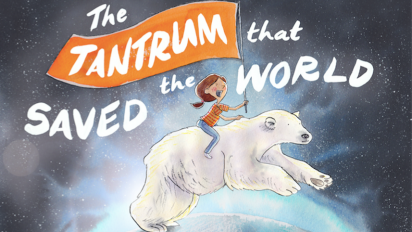When I was asked to review The Tantrum that Saved the World, by Michael E. Mann and Megan Herbert, I readily accepted. As a teacher and a parent, I know there are few children’s books available that address the most important global issue of our time—climate change.
 It’s an adult-sized issue, for sure, but sometimes it takes young voices that haven’t been muzzled by politics and special interests just to remind us to do what’s right. And besides, I could get help from twenty-one experts on children’s books—the fifth-graders in my classroom.
It’s an adult-sized issue, for sure, but sometimes it takes young voices that haven’t been muzzled by politics and special interests just to remind us to do what’s right. And besides, I could get help from twenty-one experts on children’s books—the fifth-graders in my classroom.
When we read the book aloud in our classroom, we all found it delightful and encouraging. The story focuses on Sophia, who appears to be somewhere around nine to eleven years old, a peer to my mostly ten-year-old students. She’s visited by an assortment of animals and people from around the world who have been displaced by the effects of climate change, such as lost habitat due to rising sea or food scarcity due to extended drought. Her first reaction is to hide in her room, angered by the imposition of these uninvited problems that have been thrust into her life.
"Good will costs nothing, and does nothing but good"
She soon realizes, however, that these people and animals really need her support and help: “Good will costs nothing, and does nothing but good.” Sadly, when she tries to get adults to help her and her new friends, she’s ignored. That’s when she has a tantrum, making a loud fuss and taking a multitude of actions to “save the whole world.”
While the reader is left to speculate if all of Sophia’s actions will indeed help slow down climate change, we’re left hopeful that they will. And the seed has been planted in our minds that we all need to make a fuss and encourage people to work together to mitigate climate change, so the most vulnerable can be hopeful about their future.
My students and I loved Sophia’s gumption and compassion, even though her first reaction was to avoid the situation and those complaining about it. My students said that they liked the main character and found the story fun to listen to and interesting to think about. One noted, “This book uses fun characters to explain a serious topic, so even young kids can understand.” (Okay, full disclosure: I asked them to write an essay about their opinion after the read-aloud. I couldn’t help it! I’m their language arts teacher, as well as their science teacher.)
Dr. Seuss-style Poetic Verse
They also liked that it’s written in Dr. Seuss-style poetic verse. They’re familiar with Dr. Seuss’s famous environmental story, The Lorax, and enjoyed guessing the rhyming word that was about to be read aloud at the end of each line. They also liked discussing the parallels between the two stories and their main characters.
This book is an appropriate read-aloud for children ages 7–11. There are quite a few difficult words for young readers, such as “condescension” and “conviction,” but when they experience the book as a read-aloud, supplemented with a bit of explanation, children will get the drift. The delightful pictures also provide good support to help children understand the story line.
My students especially liked the two-page picture of Sophia yelling to the world to take action about climate change. Instead of words we see all the colors of nature streaming forth from her wide-open mouth, as the narrator tells us, “It rumbled down streets, into towns of all lands. It echoed in forests, on glaciers and sands. People and creatures alike felt its force. They ditched their distractions and looked for the source.”
Some may be concerned that in the book fantasy is used to explain a scientific phenomenon. However, with a caring adult’s guidance, even young children will have no trouble understanding the difference between the cute story line created to engage, and the powerful message that we need to work together to take care of the environment. Since Aesop’s time, fictional tales have long been used to teach important lessons.
The Tantrum that Saved the World also includes nonfictional information at the end. It briefly explains climate change and how it’s already begun to affect people and animals around the world, and it provides background information that’s best read by adults and paraphrased for children. And if you’re left wondering what can be done to help slow down climate change, there’s a “World Saving Action Plan” poster tucked into the back of the book to get you started.
According to the dedication page, the authors wrote this book for their children, mindful that they will be dealing with the changing climate created by adults. You too will want to read this book to your favorite children to inspire and empower, as we work together to help them to have a bright future.
A modified version of this post originally appeared in Reports of the National Center for Science Education 38(3). If you like this review, you're going to love the whole issue.
Kottie Christie-Blick teaches at Cottage Lane Elementary School in New York. She also is an on-line course instructor for the University of San Diego and an educational consultant working to get climate change taught in classrooms around the world. @KottieCB



